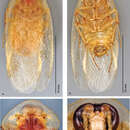Description
provided by Zookeys
Male. Measurements. Holotype TL = 20.4 mm, GW = 8.8 mm, PW = 6.22 mm, PL = 4.08 mm, TL/GW = 2.32, PL/PW = 0.65. EW = 0.25 mm; OW = 0.25 mm. Among paratypes range of TL 15.9–22.7 mm; range of GW 6.9–11.0 mm; range of PW 4.83–7.75 mm; range of PL 3.43–4.61 mm.
Head. Two ocelli very large, ovoid and protruding (0.5 × 0.4 mm), surrounded by waxy beige >0.1 mm border; vertex dark brown with small ridges in rays around upper apices of eyes and extending onto ocellar tubercles; interocellar space concave, dark brown with central medium brown dimple and two deep set medium brown dimples medial to inner apex of ocelli. Posterior frons pale orange-brown fading to waxy white towards clypeus, concave; anterior frons waxy white, bulbous; broad flat waxy white anteclypeus. See Fig. 111d.
Pronotum. Pronotum translucent, waxy beige; dorsal surface of pronotum with short fine brown setae laterally and anteriorly; pronotal pattern orange-brown “panther face” with little discernible detail; slight lateral aura. See Fig. 111c.
Body. Wing brace present. Two tarsal claws present. Legs and body light orange-brown, darker maculation laterally on each sternite; subgenital plate with darker orange-brown border; strongly asymmetrical with rounded apices. See Fig. 111b.
Forewings. Wings extended well beyond abdominal apex (~40% of wing length); light beige with occasional orange-brown blotches depending on specimen; surface translucent with slight sheen. See Fig. 111a.
Genitalia. Right dorsal phallomere composed of bulbous lightly sclerotized hook-shaped lobe, articulated with right ventral phallomere on lateral side; central field slightly sclerotized; medial margin heavily sclerotized, extending into smooth spine near distal end. Small central sclerite flat and finely punctate with posteriorly projecting, shagreened crescent in which dorsal arm of crescent is more prominently raised and toothed than ventral arm; right ventral phallomere extends from articulation to form rounded punctate structure at posterior apex but with shagreened corrugations at anterior apical end, followed by smaller offset shagreened projection and then by rounded concave arm extending beyond depth of rest of phallomere. Folded anterior portion of left phallomere setose, otherwise unmodified. Genital hook with long extension to pointed head with slight concavity on short hook; arm has distinct bend. See Fig. 112.
- bibliographic citation
- Hopkins H (2014) A revision of the genus Arenivaga (Rehn) (Blattodea, Corydiidae), with descriptions of new species and key to the males of the genus ZooKeys 384: 1–256
- author
- Heidi Hopkins
Distribution
provided by Zookeys
This species is distributed from Saline Valley Salt Marsh in its northern and western extents to San Felipe, Baja California Norte, Mexico in its southern and eastern extents. See Fig. 113.
- bibliographic citation
- Hopkins H (2014) A revision of the genus Arenivaga (Rehn) (Blattodea, Corydiidae), with descriptions of new species and key to the males of the genus ZooKeys 384: 1–256
- author
- Heidi Hopkins

